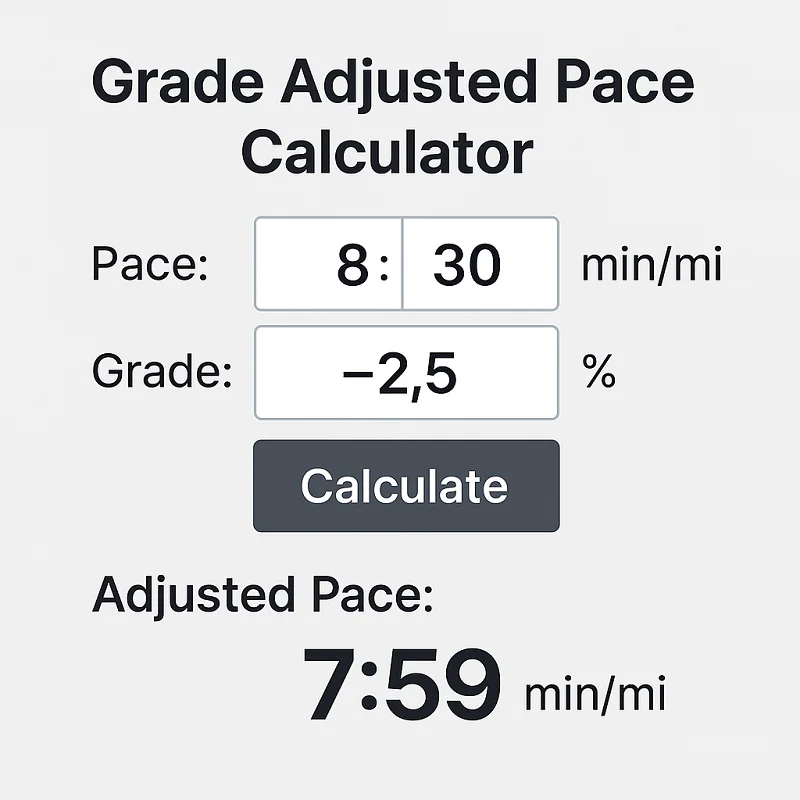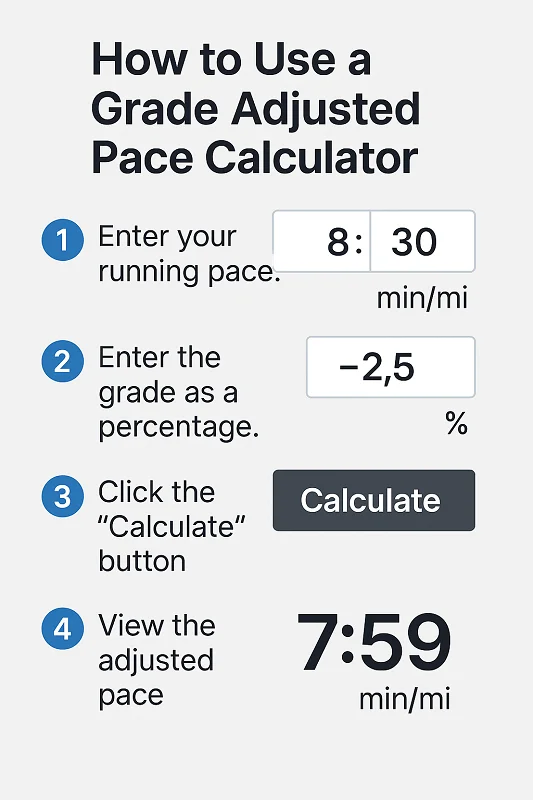Adjust your running pace based on terrain grade
Enter your pace and grade to see the adjusted pace
Running uphill feels harder than running on flat ground—that’s a fact every runner knows. But how do you accurately measure your effort when terrain varies dramatically? Enter Grade Adjusted Pace (GAP), a game-changing metric that levels the playing field by accounting for elevation changes in your running performance.
Whether you’re training for a mountain marathon or simply trying to understand why your neighborhood hill run feels so much tougher, GAP provides the missing piece of the puzzle. This comprehensive guide will walk you through everything you need to know about Grade Adjusted Pace, from the science behind it to practical applications that will transform your training approach.
Grade Adjusted Pace (GAP) is a calculated metric that adjusts your actual running pace to account for the impact of elevation changes—both uphill and downhill. Think of it as your “equivalent flat ground pace” that shows what your pace would have been if you had run the same distance with the same effort on perfectly level terrain.
For example, if you run up a steep hill at an 8:00 per mile pace, your GAP might show 7:20 per mile, indicating that your effort level was equivalent to running 7:20 pace on flat ground. Conversely, if you’re flying downhill at 6:30 pace, your GAP might reveal that your actual effort was more like 7:00 pace on flat terrain.
This adjustment is crucial because it provides a more accurate picture of your fitness level and training effort, regardless of the terrain you’re running on.
Traditional pace alone can be misleading when training on varied terrain. A runner maintaining 8:00 per mile pace on a 6% grade is working significantly harder than someone running the same pace on flat ground. GAP helps you maintain consistent effort levels across different terrains, ensuring your easy runs stay easy and your hard workouts hit the right intensity.
GAP allows you to compare performances across different courses and conditions. That hilly 10K time can now be meaningfully compared to a flat course PR, giving you a clearer picture of your actual fitness improvements over time.
Understanding how grades affect your pace helps you develop more effective race strategies. You can plan when to push harder on downhills and when to ease up on climbs while maintaining your target overall effort level.
By using GAP, you can ensure your training zones remain consistent regardless of terrain. This leads to more effective training adaptations and reduces the risk of overtraining on hilly routes.
The science of Grade Adjusted Pace is based on extensive research into how elevation changes affect running economy and energy expenditure. When you run uphill, you’re working against gravity, requiring significantly more energy per mile. Conversely, running downhill provides gravitational assistance, though it also increases impact forces and requires different muscle engagement.
Uphill Running: For every 1% increase in grade, your energy expenditure increases by approximately 3-4%. This means a 5% grade requires about 15-20% more energy than flat running. The relationship isn’t perfectly linear, but research has established reliable formulas for these calculations.
Downhill Running: Downhill running is more complex. While gravity assists forward motion, runners must also control their descent, which requires eccentric muscle contractions and increased impact absorption. The energy savings from downhill running are typically less than the energy cost of equivalent uphill running.
Research Foundation
Studies by exercise physiologists have measured oxygen consumption (VO2) at various grades to establish the relationship between grade and energy expenditure. These findings form the basis for GAP calculations, ensuring the adjustments reflect actual physiological demands rather than simple mathematical approximations.
While the exact formulas used by different GAP calculators may vary slightly, the basic principle remains consistent. Here’s a simplified approach to understanding how GAP is calculated:
Basic Formula Components
Pace Adjustment Factor:
Simplified Calculation Steps
For a 5% uphill grade, you might apply a factor of 0.85, meaning your 8:00 actual pace becomes approximately 6:48 GAP (8:00 × 0.85).
While understanding the concept is valuable, the actual calculations involve complex formulas that account for variables like grade percentage, pace, and even runner weight. Online GAP calculators handle these computations instantly and accurately, making them essential tools for practical application.

Example 1: The Hill Repeat Workout
Scenario: Sarah runs 6 × 800m hill repeats on a 4% grade
Example 2: The Trail Race Comparison
Scenario: Mike runs two 10K races
Example 3: The Marathon Negative Split
Scenario: Emma runs a point-to-point marathon with net downhill
GAP allows you to maintain consistent training intensities across varied terrain. Your lactate threshold workouts can hit the same physiological stress whether you’re running on hills or flats, leading to more effective training adaptations.
Easy runs are crucial for recovery, but maintaining “easy” effort on hills can be challenging. GAP helps ensure your recovery runs truly remain in the easy zone, preventing inadvertent overtraining.
Traditional pace-based progress tracking can be misleading when training routes vary. GAP provides a more accurate measure of fitness improvements over time, especially for runners who primarily train on hilly terrain.
Understanding your GAP capabilities helps you develop more effective race strategies. You can plan how much time to “bank” on downhills and how much to “spend” on climbs while maintaining your goal effort level.
Seeing your GAP can be incredibly motivating when you’re struggling up a tough hill. That 9:00 pace might actually represent a 7:30 effort level, providing mental encouragement to keep pushing.

GAP is highly accurate for measuring mechanical work and energy expenditure, but it doesn't account for environmental factors like heat, humidity, or wind. Heart rate can be affected by these factors as well as fatigue, caffeine, and stress. The most comprehensive approach combines GAP with heart rate data and perceived exertion for a complete picture of training stress.
GAP calculations are based on average physiological responses and work well for most runners. However, individual variations exist—some runners are naturally better hill climbers or have more efficient downhill technique. Over time, you'll learn how your personal response compares to GAP predictions.
GAP is valuable for both easy runs and hard workouts. For easy runs, it helps ensure you're truly recovering by maintaining genuinely easy effort levels. For workouts, it ensures you're hitting target intensities regardless of terrain.
GAP recognizes that downhill running requires less energy output but also accounts for the fact that the assistance from gravity isn't as dramatic as the hindrance from uphill running. The adjustments for downhill are typically smaller than equivalent uphill adjustments.
Absolutely. GAP is particularly valuable for trail running and ultra-distance events where terrain varies dramatically. It helps with pacing strategy, nutrition planning, and understanding when you're working too hard or not hard enough given the current terrain.
GAP and NGP are similar concepts with slightly different calculation methods. NGP, developed by TrainingPeaks, uses a specific algorithm that may weight recent efforts more heavily. Both serve the same general purpose of adjusting pace for grade, with minor differences in implementation.
You need a GPS watch or smartphone app that records elevation data along with pace and distance. Most modern running watches and apps can either calculate GAP in real-time or provide the data needed for post-run GAP analysis.
Start by using GAP to analyze your existing runs and understand how terrain affects your effort. Gradually begin using GAP targets for specific workouts, especially those on hilly terrain. Many coaches recommend using GAP for effort-based training while still tracking actual pace for race-specific preparation.
Grade Adjusted Pace transforms how you understand and approach running on varied terrain. By accounting for the physiological demands of hills, GAP provides a more accurate picture of your effort, fitness, and performance than traditional pace alone.
Whether you’re a recreational runner trying to understand why that hill feels so tough, a competitive athlete seeking to optimize training intensity, or a coach working with runners on diverse terrain, GAP offers invaluable insights that can improve your running performance and training effectiveness.
The beauty of GAP lies in its practical application. You don’t need to become a exercise physiologist to benefit from this powerful metric. Modern technology has made GAP calculation simple and accessible, providing instant feedback that can transform your training approach.
Ready to experience the power of Grade Adjusted Pace? Try our free online GAP calculator today. Simply input your running data—distance, time, and elevation change—and discover what your pace would have been on flat ground. Join thousands of runners who have already discovered how GAP can unlock new insights into their training and performance.
Don’t let hills intimidate you or mislead you about your fitness level. Embrace the terrain, understand your effort, and train smarter with Grade Adjusted Pace. Your running will never be the same.